Rose Qingyang Hu
Fractional Fourier Domain PAPR Reduction
Nov 13, 2024Abstract:High peak-to-average power ratio (PAPR) has long posed a challenge for multi-carrier systems, impacting amplifier efficiency and overall system performance. This paper introduces dynamic angle fractional Fourier division multiplexing (DA-FrFDM), an innovative multi-carrier system that effectively reduces PAPR for both QAM and Gaussian signals with minimal signaling overhead. DA-FrFDM leverages the fractional Fourier domain to balance PAPR characteristics between the time and frequency domains, achieving significant PAPR reduction while preserving signal quality. Furthermore, DA-FrFDM refines signal processing and enables one-tap equalization in the fractional Fourier domain through the simple multiplication of time-domain signals by a quadratic phase sequence. Our results show that DA-FrFDM not only outperforms existing PAPR reduction techniques but also retains efficient inter-carrier interference (ICI) mitigation capabilities in doubly dispersive channels.
Backdoor Attacks and Defenses on Semantic-Symbol Reconstruction in Semantic Communications
Apr 20, 2024Abstract:Semantic communication is of crucial importance for the next-generation wireless communication networks. The existing works have developed semantic communication frameworks based on deep learning. However, systems powered by deep learning are vulnerable to threats such as backdoor attacks and adversarial attacks. This paper delves into backdoor attacks targeting deep learning-enabled semantic communication systems. Since current works on backdoor attacks are not tailored for semantic communication scenarios, a new backdoor attack paradigm on semantic symbols (BASS) is introduced, based on which the corresponding defense measures are designed. Specifically, a training framework is proposed to prevent BASS. Additionally, reverse engineering-based and pruning-based defense strategies are designed to protect against backdoor attacks in semantic communication. Simulation results demonstrate the effectiveness of both the proposed attack paradigm and the defense strategies.
Exploring Communication Technologies, Standards, and Challenges in Electrified Vehicle Charging
Mar 25, 2024

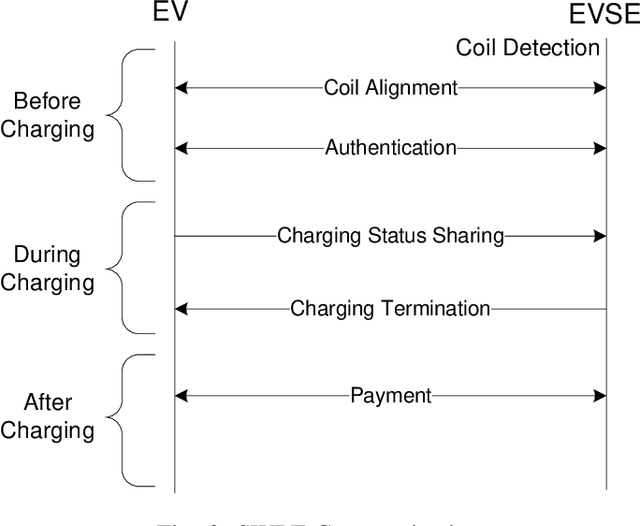

Abstract:As public awareness of environmental protection continues to grow, the trend of integrating more electric vehicles (EVs) into the transportation sector is rising. Unlike conventional internal combustion engine (ICE) vehicles, EVs can minimize carbon emissions and potentially achieve autonomous driving. However, several obstacles hinder the widespread adoption of EVs, such as their constrained driving range and the extended time required for charging. One alternative solution to address these challenges is implementing dynamic wireless power transfer (DWPT), charging EVs in motion on the road. Moreover, charging stations with static wireless power transfer (SWPT) infrastructure can replace existing gas stations, enabling users to charge EVs in parking lots or at home. This paper surveys the communication infrastructure for static and dynamic wireless charging in electric vehicles. It encompasses all communication aspects involved in the wireless charging process. The architecture and communication requirements for static and dynamic wireless charging are presented separately. Additionally, a comprehensive comparison of existing communication standards is provided. The communication with the grid is also explored in detail. The survey gives attention to security and privacy issues arising during communications. In summary, the paper addresses the challenges and outlines upcoming trends in communication for EV wireless charging.
Safeguarding Next Generation Multiple Access Using Physical Layer Security Techniques: A Tutorial
Mar 25, 2024



Abstract:Driven by the ever-increasing requirements of ultra-high spectral efficiency, ultra-low latency, and massive connectivity, the forefront of wireless research calls for the design of advanced next generation multiple access schemes to facilitate provisioning of these stringent demands. This inspires the embrace of non-orthogonal multiple access (NOMA) in future wireless communication networks. Nevertheless, the support of massive access via NOMA leads to additional security threats, due to the open nature of the air interface, the broadcast characteristic of radio propagation as well as intertwined relationship among paired NOMA users. To address this specific challenge, the superimposed transmission of NOMA can be explored as new opportunities for security aware design, for example, multiuser interference inherent in NOMA can be constructively engineered to benefit communication secrecy and privacy. The purpose of this tutorial is to provide a comprehensive overview on the state-of-the-art physical layer security techniques that guarantee wireless security and privacy for NOMA networks, along with the opportunities, technical challenges, and future research trends.
Blockage-Aware Robust Beamforming in RIS-Aided Mobile Millimeter Wave MIMO Systems
Mar 02, 2024



Abstract:Millimeter wave (mmWave) communications are sensitive to blockage over radio propagation paths. The emerging paradigm of reconfigurable intelligent surface (RIS) has the potential to overcome this issue by its ability to arbitrarily reflect the incident signals toward desired directions. This paper proposes a Neyman-Pearson (NP) criterion-based blockage-aware algorithm to improve communication resilience against blockage in mobile mmWave multiple input multiple output (MIMO) systems. By virtue of this pragmatic blockage-aware technique, we further propose an outage-constrained beamforming design for downlink mmWave MIMO transmission to achieve outage probability minimization and achievable rate maximization. To minimize the outage probability, a robust RIS beamformer with variant beamwidth is designed to combat uncertain channel state information (CSI). For the rate maximization problem, an accelerated projected gradient descent (PGD) algorithm is developed to solve the computational challenge of high-dimensional RIS phase-shift matrix (PSM) optimization. Particularly, we leverage a subspace constraint to reduce the scope of the projection operation and formulate a new Nesterov momentum acceleration scheme to speed up the convergence process of PGD. Extensive experiments confirm the effectiveness of the proposed blockage-aware approach, and the proposed accelerated PGD algorithm outperforms a number of representative baseline algorithms in terms of the achievable rate.
Knowledge Graph Driven UAV Cognitive Semantic Communication Systems for Efficient Object Detection
Jan 25, 2024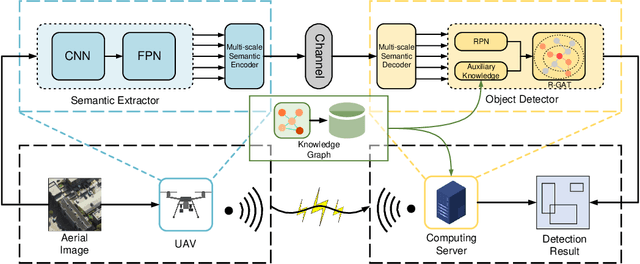
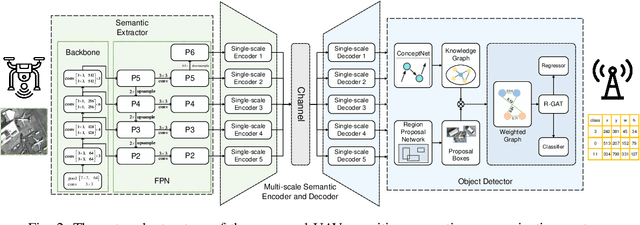
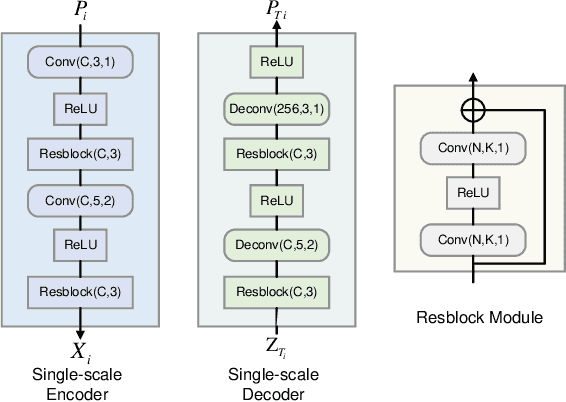
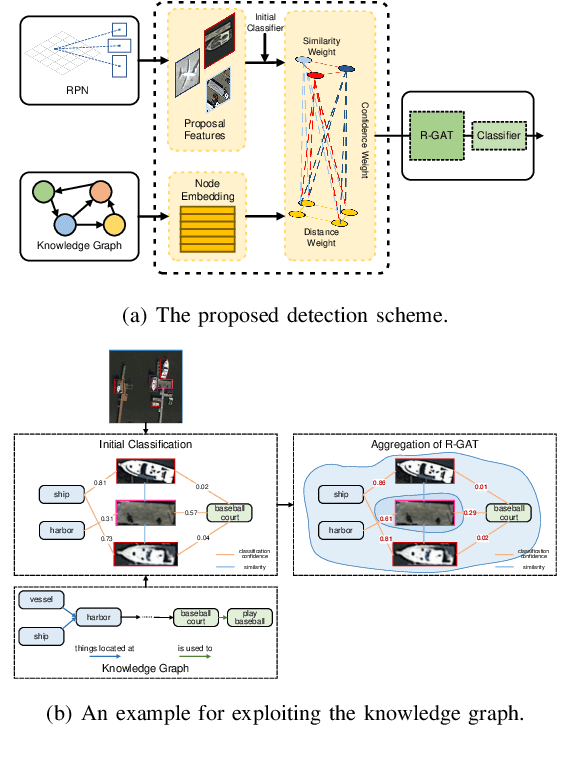
Abstract:Unmanned aerial vehicles (UAVs) are widely used for object detection. However, the existing UAV-based object detection systems are subject to the serious challenge, namely, the finite computation, energy and communication resources, which limits the achievable detection performance. In order to overcome this challenge, a UAV cognitive semantic communication system is proposed by exploiting knowledge graph. Moreover, a multi-scale compression network is designed for semantic compression to reduce data transmission volume while guaranteeing the detection performance. Furthermore, an object detection scheme is proposed by using the knowledge graph to overcome channel noise interference and compression distortion. Simulation results conducted on the practical aerial image dataset demonstrate that compared to the benchmark systems, our proposed system has superior detection accuracy, communication robustness and computation efficiency even under high compression rates and low signal-to-noise ratio (SNR) conditions.
Spatial Channel State Information Prediction with Generative AI: Towards Holographic Communication and Digital Radio Twin
Jan 16, 2024Abstract:As 5G technology becomes increasingly established, the anticipation for 6G is growing, which promises to deliver faster and more reliable wireless connections via cutting-edge radio technologies. However, efficient management method of the large-scale antenna arrays deployed by those radio technologies is crucial. Traditional management methods are mainly reactive, usually based on feedback from users to adapt to the dynamic wireless channel. However, a more promising approach lies in the prediction of spatial channel state information (spatial-CSI), which is an all-inclusive channel characterization and consists of all the feasible line-of-sight (LoS) and non-line-of-sight (NLoS) paths between the transmitter (Tx) and receiver (Rx), with the three-dimension (3D) trajectory, attenuation, phase shift, delay, and polarization of each path. Advances in hardware and neural networks make it possible to predict such spatial-CSI using precise environmental information, and further look into the possibility of holographic communication, which implies complete control over every aspect of the radio waves emitted. Based on the integration of holographic communication and digital twin, we proposed a new framework, digital radio twin, which takes advantages from both the digital world and deterministic control over radio waves, supporting a wide range of high-level applications. As a preliminary attempt towards this visionary direction, in this paper, we explore the use of generative artificial intelligence (AI) to pinpoint the valid paths in a given environment, demonstrating promising results, and highlighting the potential of this approach in driving forward the evolution of 6G wireless communication technologies.
Precise Coil Alignment for Dynamic Wireless Charging of Electric Vehicles with RFID Sensing
Dec 19, 2023Abstract:Electric vehicle (EV) has emerged as a transformative force for the sustainable and environmentally friendly future. To alleviate range anxiety caused by battery and charging facility, dynamic wireless power transfer (DWPT) is increasingly recognized as a key enabler for widespread EV adoption, yet it faces significant technical challenges, primarily in precise coil alignment. This article begins by reviewing current alignment methodologies and evaluates their advantages and limitations. We observe that achieving the necessary alignment precision is challenging with these existing methods. To address this, we present an innovative RFID-based DWPT coil alignment system, utilizing coherent phase detection and a maximum likelihood estimation algorithm, capable of achieving sub-10 cm accuracy. This system's efficacy in providing both lateral and vertical misalignment estimates has been verified through laboratory and experimental tests. We also discuss potential challenges in broader system implementation and propose corresponding solutions. This research offers a viable and promising solution for enhancing DWPT efficiency.
Energy Efficient Robust Beamforming for Vehicular ISAC with Imperfect Channel Estimation
Oct 26, 2023Abstract:This paper investigates robust beamforming for system-centric energy efficiency (EE) optimization in the vehicular integrated sensing and communication (ISAC) system, where the mobility of vehicles poses significant challenges to channel estimation. To obtain the optimal beamforming under channel uncertainty, we first formulate an optimization problem for maximizing the system EE under bounded channel estimation errors. Next, fractional programming and semidefinite relaxation (SDR) are utilized to relax the rank-1 constraints. We further use Schur complement and S-Procedure to transform Cramer-Rao bound (CRB) and channel estimation error constraints into convex forms, respectively. Based on the Lagrangian dual function and Karush-Kuhn-Tucker (KKT) conditions, it is proved that the optimal beamforming solution is rank-1. Finally, we present comprehensive simulation results to demonstrate two key findings: 1) the proposed algorithm exhibits a favorable convergence rate, and 2) the approach effectively mitigates the impact of channel estimation errors.
Map2Schedule: An End-to-End Link Scheduling Method for Urban V2V Communications
Oct 12, 2023Abstract:Urban vehicle-to-vehicle (V2V) link scheduling with shared spectrum is a challenging problem. Its main goal is to find the scheduling policy that can maximize system performance (usually the sum capacity of each link or their energy efficiency). Given that each link can experience interference from all other active links, the scheduling becomes a combinatorial integer programming problem and generally does not scale well with the number of V2V pairs. Moreover, link scheduling requires accurate channel state information (CSI), which is very difficult to estimate with good accuracy under high vehicle mobility. In this paper, we propose an end-to-end urban V2V link scheduling method called Map2Schedule, which can directly generate V2V scheduling policy from the city map and vehicle locations. Map2Schedule delivers comparable performance to the physical-model-based methods in urban settings while maintaining low computation complexity. This enhanced performance is achieved by machine learning (ML) technologies. Specifically, we first deploy the convolutional neural network (CNN) model to estimate the CSI from street layout and vehicle locations and then apply the graph embedding model for optimal scheduling policy. The results show that the proposed method can achieve high accuracy with much lower overhead and latency.
 Add to Chrome
Add to Chrome Add to Firefox
Add to Firefox Add to Edge
Add to Edge